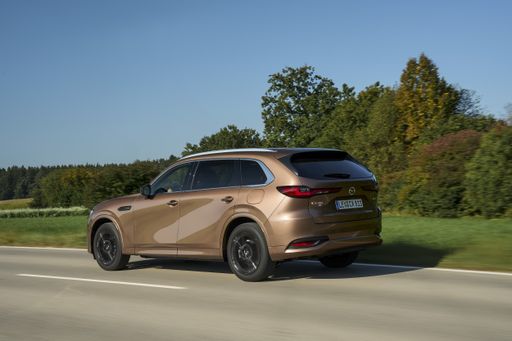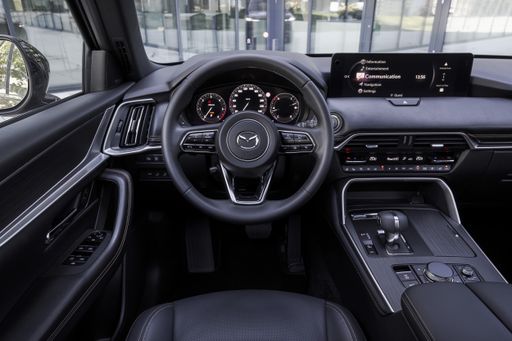As families and adventure-seekers alike look for reliable and versatile SUVs, the competition in this segment heats up. In this article, we take a closer look at two standout models: the Kia Sorento and the Mazda CX-80. With their striking features and innovative technologies, both SUVs promise an exceptional driving experience. Let’s dive into the technical aspects that make these vehicles appealing.
Kia Sorento vs Mazda CX-80 – Which one offers the better deal?
Compare performance, boot capacity, efficiency and price at a glance.
Find out which car is the better choice for you – Kia Sorento or Mazda CX-80?
Powertrain and Performance
The Kia Sorento offers a versatile range of engine options, including plugin hybrid, full hybrid, and diesel variants. The power outputs range from 194 HP to an impressive 252 HP, along with torque figures reaching up to 440 Nm. Its various configurations allow for both front-wheel drive and all-wheel drive capabilities, providing suitable options for different terrains and driving needs. The Sorento also boasts decent acceleration with times between 8.8 and 9.7 seconds for the 0-100 km/h sprint, depending on the chosen engine.
On the other hand, the Mazda CX-80 comes equipped with a more powerful engine, with a plugin hybrid option and a diesel MHEV engine configuration that generates up to 327 HP, providing a whopping 550 Nm of torque. The CX-80 accelerates from 0-100 km/h in just 6.8 seconds, highlighting its sporty edge over the Sorento. Both vehicles are available with all-wheel drive and come with an automatic gearbox for a seamless driving experience.
Fuel Efficiency and Emissions
Fuel consumption is an essential factor for many consumers. The Kia Sorento offers impressive fuel efficiency, with its hybrid models consuming as little as 1.6 L/100km in certain configurations, while its diesel engines maintain competitive numbers around 6.8 L/100km. The CO2 emissions for the Sorento vary, but the efficient hybrid options fall under class B, helping to reduce the vehicle’s environmental impact.
The Mazda CX-80 also excels in this category, with a commendable 1.6 L/100km fuel consumption figure for its hybrid variant. Its diesel models post ratings of around 5.7 L/100km and CO2 emissions as low as 35 g/km, reinforcing Mazda's commitment to sustainability and efficiency.
Interior Space and Comfort
There’s no denying that both SUVs emphasize passenger comfort and space. The Kia Sorento, with seating for up to seven, offers a flexible cabin layout with sufficient room for families. The trunk capacity ranges from 175 to an impressive 705 liters, depending on the configuration, accommodating various cargo needs.
In comparison, the Mazda CX-80 also seats seven passengers but has a smaller trunk capacity of 258 liters, which may be a consideration for those needing ample cargo space. However, Mazda focuses greatly on premium materials and ergonomic design, creating a cozy cabin feel for all occupants. Both SUVs come equipped with state-of-the-art infotainment systems that enhance the driving experience.
Technological Innovations
In today’s automotive landscape, technology plays a pivotal role. The Kia Sorento includes innovative features such as advanced safety systems, user-friendly infotainment, and connectivity options supporting smartphone integration. Moreover, its hybrid technology provides significant reductions in fuel consumption without sacrificing performance.
Conversely, the Mazda CX-80 is noted for its engaging driving dynamics and premium technology. It showcases Mazda’s latest advancements in driver-assistance systems, ensuring enhanced safety and convenience for all passengers. The infotainment interface is intuitive, allowing drivers easy access to navigation, media, and communication features.
Conclusion
In the face of increasing competition in the SUV segment, both the Kia Sorento and Mazda CX-80 present strong cases for family-oriented buyers. The Sorento shines with its flexible seating arrangements and impressive range of engine options, while the CX-80 stands out with its sharp performance and engaging driving experience. Ultimately, the choice depends on individual priorities, be it fuel efficiency, space, performance, or advanced technology. Both vehicles undoubtedly cater to a wide range of consumer needs, solidifying their places in the competitive SUV market.
Here’s where it gets real: The technical differences in detail
Costs and Efficiency:
Looking at overall running costs, both models reveal some interesting differences in everyday economy.
Kia Sorento has a barely noticeable advantage in terms of price – it starts at 46000 £, while the Mazda CX-80 costs 48200 £. That’s a price difference of around 2194 £.
Both cars consume an average of 1.60 L per 100 km – no difference here.
As for range, the Mazda CX-80 performs hardly perceptible better – achieving up to 61 km, about 6 km more than the Kia Sorento.
Engine and Performance:
Power, torque and acceleration are the classic benchmarks for car enthusiasts – and here, some clear differences start to show.
When it comes to engine power, the Mazda CX-80 has a evident edge – offering 327 HP compared to 252 HP. That’s roughly 75 HP more horsepower.
In acceleration from 0 to 100 km/h, the Mazda CX-80 is noticeable quicker – completing the sprint in 6.80 s, while the Kia Sorento takes 8.80 s. That’s about 2 s faster.
In terms of top speed, the Mazda CX-80 performs hardly perceptible better – reaching 219 km/h, while the Kia Sorento tops out at 201 km/h. The difference is around 18 km/h.
There’s also a difference in torque: Mazda CX-80 pulls slightly stronger with 550 Nm compared to 440 Nm. That’s about 110 Nm difference.
Space and Everyday Use:
Whether family car or daily driver – which one offers more room, flexibility and comfort?
Both vehicles offer seating for 7 people.
In curb weight, Kia Sorento is to a small extent lighter – 1854 kg compared to 2131 kg. The difference is around 277 kg.
In terms of boot space, the Kia Sorento offers decisively more room – 705 L compared to 258 L. That’s a difference of about 447 L.
In maximum load capacity, the Kia Sorento performs hardly perceptible better – up to 2100 L, which is about 129 L more than the Mazda CX-80.
When it comes to payload, Kia Sorento slight takes the win – 684 kg compared to 650 kg. That’s a difference of about 34 kg.
Who wins the race?
The Mazda CX-80 proves to be leaves the rival little chance and therefore becomes our DriveDuel Champion!
Mazda CX-80 is the better all-rounder in this comparison.
 @ Mazda Motor Corporation
@ Mazda Motor Corporation
Mazda CX-80
Kia Sorento
The Kia Sorento is a versatile SUV that seamlessly blends style and practicality, making it an appealing choice for families and adventurers alike. With its spacious interior and thoughtful design features, it ensures a comfortable driving experience on both urban roads and country excursions. Additionally, the Sorento offers a suite of advanced safety technologies, enhancing peace of mind for its passengers.
details @ Kia Corporation
@ Kia Corporation
 @ Kia Corporation
@ Kia Corporation
 @ Kia Corporation
@ Kia Corporation
Mazda CX-80
The Mazda CX-80 exemplifies a perfect blend of sophisticated design and dynamic performance, making it a standout model in the SUV market. With its sleek lines and contemporary interior, it delivers a sense of luxury typically reserved for higher-end marques. This model also offers impressive handling and a comfortable ride, ensuring an enjoyable driving experience in various conditions.
details @ Mazda Motor Corporation
@ Mazda Motor Corporation
 @ Mazda Motor Corporation
@ Mazda Motor Corporation
 @ Mazda Motor Corporation
@ Mazda Motor Corporation
 @ Kia Corporation
@ Kia Corporation
|
 @ Mazda Motor Corporation
@ Mazda Motor Corporation
|
|
|
|
Costs and Consumption |
|
|---|---|
|
Price
46000 - 59300 £
|
Price
48200 - 60200 £
|
|
Consumption L/100km
1.6 - 7.2 L
|
Consumption L/100km
1.6 - 5.8 L
|
|
Consumption kWh/100km
-
|
Consumption kWh/100km
-
|
|
Electric Range
55 km
|
Electric Range
61 km
|
|
Battery Capacity
-
|
Battery Capacity
-
|
|
co2
37 - 174 g/km
|
co2
35 - 151 g/km
|
|
Fuel tank capacity
47 - 67 L
|
Fuel tank capacity
70 - 74 L
|
Dimensions and Body |
|
|---|---|
|
Body Type
SUV
|
Body Type
SUV
|
|
Seats
5 - 7
|
Seats
7
|
|
Doors
5
|
Doors
5
|
|
Curb weight
1854 - 2105 kg
|
Curb weight
2131 - 2240 kg
|
|
Trunk capacity
175 - 705 L
|
Trunk capacity
258 L
|
|
Length
4810 - 4815 mm
|
Length
4995 mm
|
|
Width
1900 mm
|
Width
1890 mm
|
|
Height
1695 mm
|
Height
1714 mm
|
|
Max trunk capacity
1988 - 2100 L
|
Max trunk capacity
1971 L
|
|
Payload
455 - 684 kg
|
Payload
649 - 650 kg
|
Engine and Performance |
|
|---|---|
|
Engine Type
Plugin Hybrid, Full Hybrid, Diesel
|
Engine Type
Plugin Hybrid, Diesel MHEV
|
|
Transmission
Automatic
|
Transmission
Automatic
|
|
Transmission Detail
Automatic Gearbox, Dual-Clutch Automatic
|
Transmission Detail
Automatic Gearbox
|
|
Drive Type
All-Wheel Drive, Front-Wheel Drive
|
Drive Type
All-Wheel Drive
|
|
Power HP
194 - 252 HP
|
Power HP
254 - 327 HP
|
|
Acceleration 0-100km/h
8.8 - 9.7 s
|
Acceleration 0-100km/h
6.8 - 8.4 s
|
|
Max Speed
183 - 201 km/h
|
Max Speed
195 - 219 km/h
|
|
Torque
367 - 440 Nm
|
Torque
500 - 550 Nm
|
|
Number of Cylinders
4
|
Number of Cylinders
4 - 6
|
|
Power kW
142 - 185 kW
|
Power kW
187 - 241 kW
|
|
Engine capacity
1598 - 2151 cm3
|
Engine capacity
2488 - 3283 cm3
|
General |
|
|---|---|
|
Model Year
2024
|
Model Year
2024
|
|
CO2 Efficiency Class
B, E, F
|
CO2 Efficiency Class
B, E
|
|
Brand
Kia
|
Brand
Mazda
|
What drivetrain options does the Kia Sorento have?
The Kia Sorento is available as All-Wheel Drive or Front-Wheel Drive.
The prices and data displayed are estimates based on German list prices and may vary by country. This information is not legally binding.
